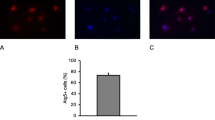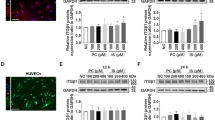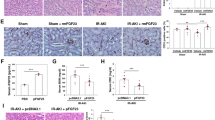Abstract
Renal ischemia rapidly mobilizes endothelial progenitor cells (EPCs), which provides renoprotection in acute kidney injury (AKI). Indoxyl sulfate (IS) is a protein-binding uremic toxin with a potential role in endothelial injury. In this study, we examined the effects and mechanisms of action of IS on EPCs in AKI. Forty-one consecutive patients (26 male; age, 70.1 ± 14.1 years) diagnosed with AKI according to the AKIN criteria were enrolled. The AKI patients had higher serum IS levels than patients with normal kidney function (1.35 ± 0.94 × 10−4M vs. 0.02 ± 0.02 × 10−4M, P < 0.01). IS levels were negatively correlated to the number of double-labeled (CD34+KDR+) circulating EPCs (P < 0.001). After IS stimulation, the cells displayed decreased expression of phosphorylated endothelial nitric oxide (NO) synthase, vascular cell adhesion molecule-1, increased reactive oxygen species, decreased proliferative capacity, increased senescence and autophagy, as well as decreased migration and angiogenesis. These effects of IS on EPCs were reversed by atorvastatin. Further, exogenous administration of IS significantly reduced EPC number in Tie2-GFP transgenic mice and attenuated NO signaling in aortic and kidney arteriolar endothelium after kidney ischemia–reperfusion injury in mice, and these effects were restored by atorvastatin. Our results are the first to demonstrate that circulating IS is elevated in AKI and has direct effects on EPCs via NO-dependent mechanisms both in vitro and in vivo. Targeting the IS-mediated pathways by NO-releasing statins such as atorvastatin may preempt disordered vascular wall pathology, and represent a novel EPC-rescued approach to impaired neovascularization after AKI.









Similar content being viewed by others
Abbreviations
- AKI:
-
Acute kidney injury
- APO:
-
Apocynin
- ATO:
-
Atorvastatin
- CKD:
-
Chronic kidney disease
- CASP3:
-
Activated caspase 3
- Ctrl:
-
Control
- DAPI:
-
DNA fluorochrome 4′-6-diamidine-2-phenyl indole
- DCFDA:
-
Dichlorofluorescin diacetate
- eNOs:
-
Endothelial nitric oxide synthase
- EPC:
-
Endothelial progenitor cells
- ESRD:
-
End stage renal disease
- FITC:
-
Fluorescein isothiocyanate
- GAM:
-
Generalized additive model
- ICAM-1:
-
Intercellular adhesion molecule 1
- IS:
-
Indoxyl sulfate
- LC3:
-
Light Chain 3
- MTT:
-
3-(4,5-cimethylthiazol-2-yl)-2,5-diphenyl tetrazolium bromide
- NAC:
-
N-acetylcsyteine
- NO:
-
Nitric oxide
- NOx:
-
Reactive nitrogen species
- NSARF:
-
National Taiwan University Hospital Study Group on Acute Renal Failure
- OAT:
-
Organic anion transporter
- ROS:
-
Reactive oxygen species
- SNP:
-
Sodium nitroprusside
- Prob:
-
Probenecid
- TNF:
-
Transforming growth factor
- TUNEL:
-
Terminal deoxyribonucleotidyl transferase (TDT)-mediated dUTP-digoxigenin nick end labeling
- VCAM:
-
Vascular cell adhesion molecule
- VWF:
-
Von Willebrand factor
References
Reddy VG (2002) Prevention of postoperative acute renal failure. J Postgrad Med 48:64–70
Patschan D, Patschan S, Wessels JT et al (2010) Epac-1 activator 8-O-cAMP augments renoprotective effects of syngeneic [corrected] murine EPCs in acute ischemic kidney injury. Am J Physiol Renal Physiol 298:F78–F85
Vanholder R, De Smet R (1999) Pathophysiologic effects of uremic retention solutes. J Am Soc Nephrol 10:1815–1823
Yu M, Kim YJ, Kang DH (2011) Indoxyl sulfate-induced endothelial dysfunction in patients with chronic kidney disease via an induction of oxidative stress. Clin J Am Soc Nephrol 6:30–39
Dou L, Bertrand E, Cerini C et al (2004) The uremic solutes p-cresol and indoxyl sulfate inhibit endothelial proliferation and wound repair. Kidney Int 65:442–451
Dou L, Jourde-Chiche N, Faure V et al (2007) The uremic solute indoxyl sulfate induces oxidative stress in endothelial cells. J Thromb Haemost 5:1302–1308
Sato B, Yoshikawa D, Ishii H et al (2012) Relation of plasma indoxyl sulfate levels and estimated glomerular filtration rate to left ventricular diastolic dysfunction. Am J Cardiol. doi:10.1016/j.amjcard.2012.11.025
Barreto FC, Barreto DV, Liabeuf S et al (2009) Serum indoxyl sulfate is associated with vascular disease and mortality in chronic kidney disease patients. Clin J Am Soc Nephrol 4:1551–1558
Lekawanvijit S, Kompa AR, Wang BH et al (2012) Cardiorenal syndrome: the emerging role of protein-bound uremic toxins. Circ Res 111:1470–1483
Matsuzaki T, Watanabe H, Yoshitome K et al (2007) Downregulation of organic anion transporters in rat kidney under ischemia/reperfusion-induced acute [corrected] renal failure. Kidney Int 71:539–547
Brodsky SV, Yamamoto T, Tada T et al (2002) Endothelial dysfunction in ischemic acute renal failure: rescue by transplanted endothelial cells. Am J Physiol Renal Physiol 282:F1140–F1149
Yamamoto T, Tada T, Brodsky SV et al (2002) Intravital videomicroscopy of peritubular capillaries in renal ischemia. Am J Physiol Renal Physiol 282:F1150–F1155
Horbelt M, Lee SY, Mang HE et al (2007) Acute and chronic microvascular alterations in a mouse model of ischemic acute kidney injury. Am J Physiol Renal Physiol 293:F688–F695
Basile DP, Friedrich JL, Spahic J et al (2011) Impaired endothelial proliferation and mesenchymal transition contribute to vascular rarefaction following acute kidney injury. Am J Physiol Renal Physiol 300:F721–F733
Hill JM, Zalos G, Halcox JP et al (2003) Circulating endothelial progenitor cells, vascular function, and cardiovascular risk. N Engl J Med 348:593–600
Werner N, Kosiol S, Schiegl T et al (2005) Circulating endothelial progenitor cells and cardiovascular outcomes. N Engl J Med 353:999–1007
Becherucci F, Mazzinghi B, Ronconi E et al (2009) The role of endothelial progenitor cells in acute kidney injury. Blood Purif 27:261–270
Patschan D, Plotkin M, Goligorsky MS (2006) Therapeutic use of stem and endothelial progenitor cells in acute renal injury: ca ira. Curr Opin Pharmacol 6:176–183
Patschan D, Krupincza K, Patschan S et al (2006) Dynamics of mobilization and homing of endothelial progenitor cells after acute renal ischemia: modulation by ischemic preconditioning. Am J Physiol Renal Physiol 291:F176–F185
Schmidt-Lucke C, Rossig L, Fichtlscherer S et al (2005) Reduced number of circulating endothelial progenitor cells predicts future cardiovascular events: proof of concept for the clinical importance of endogenous vascular repair. Circulation 111:2981–2987
Patschan SA, Patschan D, Temme J et al (2011) Endothelial progenitor cells (EPC) in sepsis with acute renal dysfunction (ARD). Crit Care 15:R94
Huang TM, Wu VC, Young GH et al (2011) Preoperative proteinuria predicts adverse renal outcomes after coronary artery bypass grafting. J Am Soc Nephrol 22:156–163
Wu VC, Wang CH, Wang WJ et al (2009) Sustained low-efficiency dialysis versus continuous veno-venous hemofiltration for postsurgical acute renal failure. Am J Surg 199:466–476
Wu VC, Ko WJ, Chang HW et al (2007) Early renal replacement therapy in patients with postoperative acute liver failure associated with acute renal failure: effect on postoperative outcomes. J Am Coll Surg 205:266–276
Wu VC, Ko WJ, Chang HW et al (2008) Risk factors of early redialysis after weaning from postoperative acute renal replacement therapy. Intensive Care Med 34:101–108
Mehta RL, Kellum JA, Shah SV et al (2007) Acute kidney injury network: report of an initiative to improve outcomes in acute kidney injury. Crit Care 11:R31
Wu VC, Huang TM, Lai CF et al (2011) Acute-on-chronic kidney injury at hospital discharge is associated with long-term dialysis and mortality. Kidney Int 80:1222–1230
Huang PH, Chen YH, Tsai HY et al (2010) Intake of red wine increases the number and functional capacity of circulating endothelial progenitor cells by enhancing nitric oxide bioavailability. Arterioscler Thromb Vasc Biol 30:869–877
Huang PH, Chen YH, Wang CH et al (2009) Matrix metalloproteinase-9 is essential for ischemia-induced neovascularization by modulating bone marrow-derived endothelial progenitor cells. Arterioscler Thromb Vasc Biol 29:1179–1184
Chen YH, Lin SJ, Lin FY et al (2007) High glucose impairs early and late endothelial progenitor cells by modifying nitric oxide-related but not oxidative stress-mediated mechanisms. Diabetes 56:1559–1568
Wu VC, Lo SC, Chen YL et al (2011) Endothelial progenitor cells in primary aldosteronism: a biomarker of severity for aldosterone vasculopathy and prognosis. J Clin Endocrinol Metab 96:3175–3183
Cristofalo VJ, Allen RG, Pignolo RJ et al (1998) Relationship between donor age and the replicative lifespan of human cells in culture: a reevaluation. Proc Natl Acad Sci USA 95:10614–10619
Guedez L, Rivera AM, Salloum R et al (2003) Quantitative assessment of angiogenic responses by the directed in vivo angiogenesis assay. Am J Pathol 162:1431–1439
Sun CY, Chang SC, Wu MS (2012) Suppression of Klotho expression by protein-bound uremic toxins is associated with increased DNA methyltransferase expression and DNA hypermethylation. Kidney Int 81:640–650
Lin SL, Kisseleva T, Brenner DA et al (2008) Pericytes and perivascular fibroblasts are the primary source of collagen-producing cells in obstructive fibrosis of the kidney. Am J Pathol 173:1617–1627
Peters SO, Bauermeister K, Simon JP et al (2002) Quantitative polymerase chain reaction-based assay with fluorogenic Y-chromosome specific probes to measure bone marrow chimerism in mice. J Immunol Methods 260:109–116
Woo MJ, Reiter JP, Karr AF (2008) Estimation of propensity scores using generalized additive models. Stat Med 27:3805–3816
Madero M, Wassel CL, Peralta CA et al (2009) Cystatin C associates with arterial stiffness in older adults. J Am Soc Nephrol 20:1086–1093
Hoke M, Amighi J, Mlekusch W et al (2010) Cystatin C and the risk for cardiovascular events in patients with asymptomatic carotid atherosclerosis. Stroke 41:674–679
Jin H, Aiyer A, Su J et al (2006) A homing mechanism for bone marrow-derived progenitor cell recruitment to the neovasculature. J Clin Invest 116:652–662
Duan H, Cheng L, Sun X et al (2006) LFA-1 and VLA-4 involved in human high proliferative potential-endothelial progenitor cells homing to ischemic tissue. Thromb Haemost 96:807–815
Vanholder R, De Smet R, Glorieux G et al (2003) Review on uremic toxins: classification, concentration, and interindividual variability. Kidney Int 63:1934–1943
Cooke JP, Losordo DW (2002) Nitric oxide and angiogenesis. Circulation 105:2133–2135
Morbidelli L, Donnini S, Ziche M (2003) Role of nitric oxide in the modulation of angiogenesis. Curr Pharm Des 9:521–530
Landmesser U, Engberding N, Bahlmann FH et al (2004) Statin-induced improvement of endothelial progenitor cell mobilization, myocardial neovascularization, left ventricular function, and survival after experimental myocardial infarction requires endothelial nitric oxide synthase. Circulation 110:1933–1939
Everaert BR, Van Craenenbroeck EM, Hoymans VY et al (2010) Current perspective of pathophysiological and interventional effects on endothelial progenitor cell biology: focus on PI3 K/AKT/eNOS pathway. Int J Cardiol 144:350–366
Wood KC, Hebbel RP, Lefer DJ et al (2006) Critical role of endothelial cell-derived nitric oxide synthase in sickle cell disease-induced microvascular dysfunction. Free Radic Biol Med 40:1443–1453
Zhang J, Xie Z, Dong Y et al (2008) Identification of nitric oxide as an endogenous activator of the AMP-activated protein kinase in vascular endothelial cells. J Biol Chem 283:27452–27461
Walter DH, Rittig K, Bahlmann FH et al (2002) Statin therapy accelerates reendothelialization: a novel effect involving mobilization and incorporation of bone marrow-derived endothelial progenitor cells. Circulation 105:3017–3024
Momi S, Impagnatiello F, Guzzetta M et al (2007) NCX 6560, a nitric oxide-releasing derivative of atorvastatin, inhibits cholesterol biosynthesis and shows anti-inflammatory and anti-thrombotic properties. Eur J Pharmacol 570:115–124
Bao XM, Wu CF, Lu GP (2010) Atorvastatin inhibits homocysteine-induced oxidative stress and apoptosis in endothelial progenitor cells involving Nox4 and p38MAPK. Atherosclerosis 210:114–121
Dimmeler S, Aicher A, Vasa M et al (2001) HMG-CoA reductase inhibitors (statins) increase endothelial progenitor cells via the PI 3-kinase/Akt pathway. J Clin Invest 108:391–397
Otsuki M, Goya K, Kasayama S (2005) Vascular endothelium as a target of beraprost sodium and fenofibrate for antiatherosclerotic therapy in type 2 diabetes mellitus. Vasc Health Risk Manag 1:209–215
Young GH, Wu VC (2012) KLOTHO methylation is linked to uremic toxins and chronic kidney disease. Kidney Int 81:611–612
Acknowledgments
The authors would like to thank the staff of the Second Core Lab of the Department of Medical Research in the National Taiwan University Hospital for technical assistance. This study was supported by The Ta-Tung Kidney Foundation, Taiwan National Science Council (Grant NSC 101-2314-B-002-132-MY3, Grant NSC 101-2314-B-002-085-MY3, and Grant NSC 100-2314-B-002-119-), 100-N1776 from NTUH, 101-M1953, 102-S2097 and NTUH-TVGH Joint Research Program (VN9803, VN9906 and VN10009).
Conflict of interest
The authors have nothing to disclose.
Author information
Authors and Affiliations
Consortia
Corresponding author
Additional information
Vin-Cent Wu and Guang-Huar Young contributed equally to this work.
ClinicalTrials#. Gov number, NCT00451373.
Electronic supplementary material
Below is the link to the electronic supplementary material.
Rights and permissions
About this article
Cite this article
Wu, VC., Young, GH., Huang, PH. et al. In acute kidney injury, indoxyl sulfate impairs human endothelial progenitor cells: modulation by statin. Angiogenesis 16, 609–624 (2013). https://doi.org/10.1007/s10456-013-9339-8
Received:
Accepted:
Published:
Issue Date:
DOI: https://doi.org/10.1007/s10456-013-9339-8




